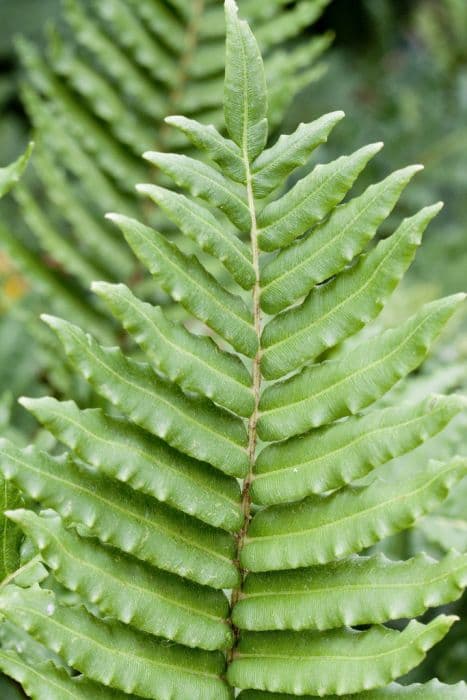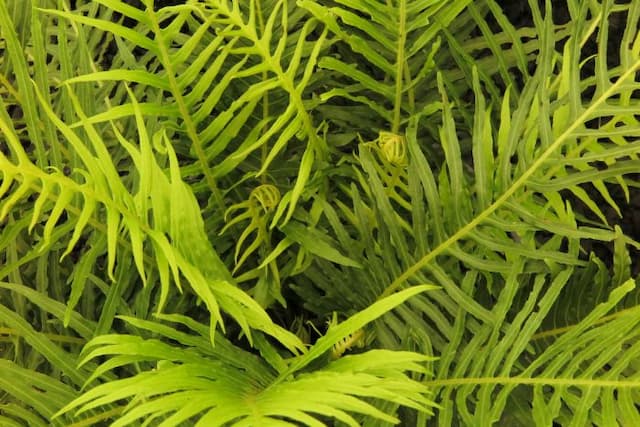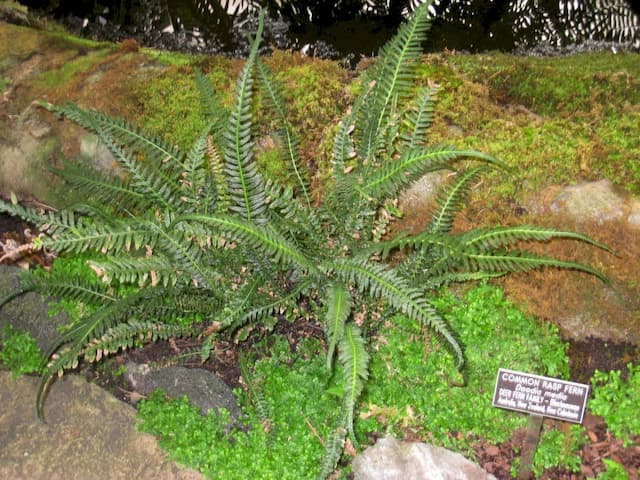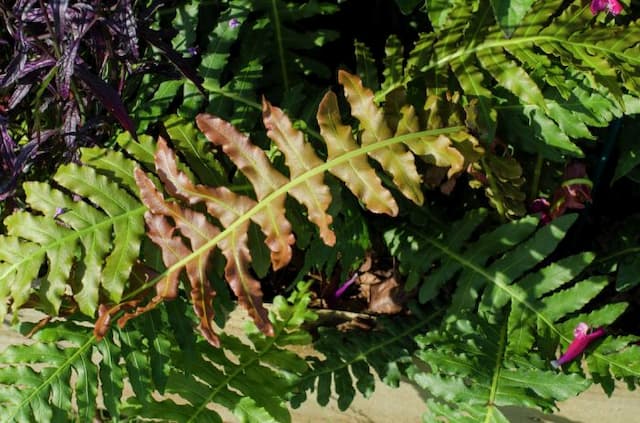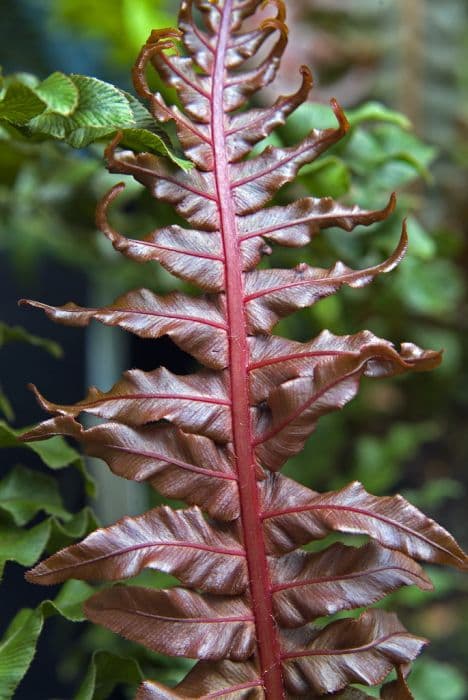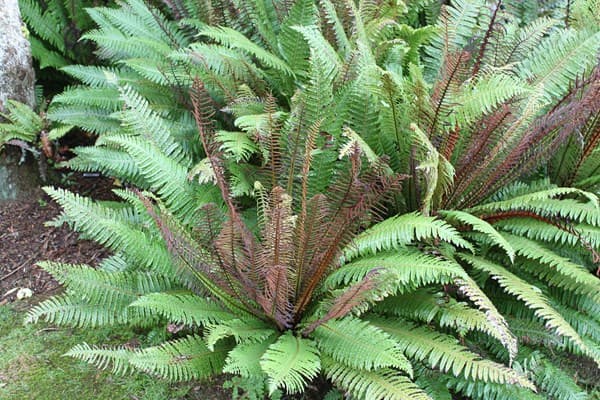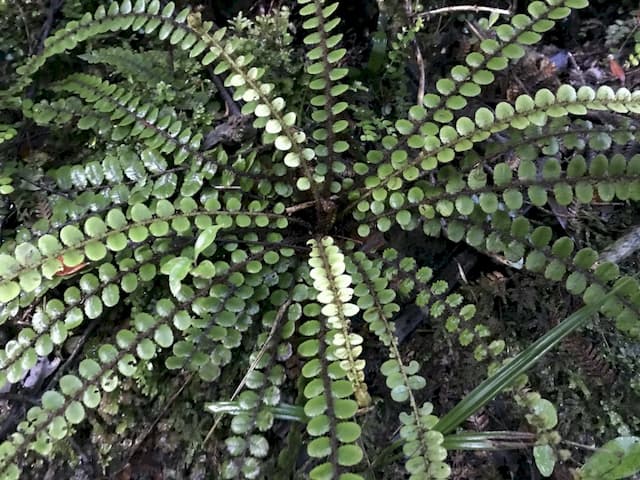Deer Fern Blechnum spicant

ABOUT
Blechnum spicant, commonly known as hard fern or deer fern, features a unique appearance characterized by two distinct types of fronds. The sterile fronds, which do not produce spores, are evergreen and arch elegantly from the center of the plant. They are glossy and lance-shaped, with a dark green coloration that remains vibrant throughout the year. The edges of these fronds are neatly toothed, adding a subtle texture to the plant's look. As for the fertile fronds, they stand more upright and are typically found in the center of the sterile ones. These fronds are comparatively more slender, and during the reproductive period, they bear spore-producing structures on the underside. When these spores mature, the fertile fronds turn brown in contrast to the lush green of the sterile leaves around them. The plant generally forms a neat, symmetrical clump. Its fronds originate from a central, short, thick stalk that is mostly hidden by the foliage above. The symmetry and the contrast between the fertile and sterile fronds give the hard fern an attractive and easily recognizable appearance.
About this plant
 Names
NamesFamily
Blechnaceae
Synonyms
Deer Fern, Hard Fern, Northern Deer Fern, Spiny Wood Fern, Buckler Fern
Common names
Blechnum boreale, Struthiopteris spicant, Lomaria spicant, Aspidium spicant, Blechnum spicant var. simplicifrons, Blechnum spicant var. obtusatum, Blechnum spicant var. elongatum, Blechnum spicant var. fallax, Blechnum spicant var. intermedium
 Toxicity
ToxicityTo humans
The plant known as Deer Fern (Blechnum spicant) is not commonly associated with being toxic to humans. There is limited information regarding its toxicity, and it is generally not considered a hazardous plant to handle or ingest in small quantities. However, as with many plants, it is not recommended to consume any part of the Deer Fern without proper knowledge and preparation, as sensitivity to the plant can vary among individuals. If ingested in large amounts, there could be the potential for gastrointestinal discomfort or other adverse reactions, but specific symptoms of poisoning are not well-documented for this species.
To pets
Similar to its effects on humans, Deer Fern (Blechnum spicant) is not typically known to be toxic to pets. There is little evidence to suggest that pets, such as cats and dogs, experience significant poisoning from ingesting the fern. While Deer Fern is not reported to have harmful effects, it is always prudent to prevent pets from consuming plants as they may cause gastrointestinal upset or other health issues in certain cases, and individual animals might have unique sensitivities. If you suspect your pet has ingested any part of a Deer Fern and is showing signs of illness, it is recommended to consult with a veterinarian.
 Characteristics
CharacteristicsLife cycle
Perennials
Foliage type
Evergreen
Color of leaves
Green
Height
1-2 feet (30-60 cm)
Spread
1-2 feet (30-60 cm)
Plant type
Fern
Hardiness zones
5-9
Native area
Europe, Western Asia
Benefits
 General Benefits
General Benefits- Erosion control: Blechnum spicant, commonly known as Deer Fern, is effective in stabilizing soil and preventing erosion due to its dense root system.
- Habitat creation: Deer Fern creates a natural habitat for wildlife, offering shelter and breeding grounds for various insect species.
- Aesthetic appeal: With its lush, green foliage and attractive fronds, Deer Fern is widely used in shade gardens and woodland settings for ornamental purposes.
- Low maintenance: Deer Fern requires minimal care once established, making it ideal for gardeners seeking low-maintenance landscaping options.
- Drought resistance: Once established, Deer Fern can tolerate periods of dryness, making it suitable for gardens in regions with occasional droughts.
- Shade tolerance: This plant thrives in shady conditions, allowing it to be planted in areas where other plants might struggle due to a lack of sunlight.
- Cultural significance: Deer Fern has cultural importance to indigenous peoples in some regions, where it has been used in traditional practices and ceremonies.
 Medical Properties
Medical Properties- Anti-inflammatory: Historically, it has been used for its potential anti-inflammatory properties.
- Astringent: Blechnum spicant may contain astringent compounds beneficial in topical applications.
- Diuretic: There have been some references to its use as a diuretic, promoting the production of urine.
 Air-purifying Qualities
Air-purifying QualitiesThis plant is not specifically known for air purifying qualities.
 Other Uses
Other Uses- Garden Ornamental: Deer fern, with its striking foliage and hardiness, is popular for shady garden landscapes and woodland settings.
- Floristry: The fronds are used in floral arrangements and bouquets for their texture and long-lasting nature.
- Ground Cover: The deer fern can serve as an attractive and low-maintenance ground cover in suitable moist and shaded environments.
- Erosion Control: Its dense growth habits make it suitable for stabilizing soil in erosion-prone areas.
- Crafts: Fronds are sometimes used in arts and crafts for their unique patterns and can be pressed into books or framed.
- Fernery Collections: Deer fern is a common choice for fern enthusiasts creating ferneries due to its unique appearance.
- Show Plants: Because of its distinctive look, it is often used in horticultural shows and competitions.
- Indicator Species: Sometimes used in ecology as an indicator species to signify the presence of a certain type of ecosystem, like damp forests.
- Basketry: Historically, indigenous peoples may have used the rigid stems of deer fern in traditional basket weaving techniques.
- Nature Education: Deer fern can be used as a teaching tool in nature classes to educate students about native plant species and biodiversity.
Interesting Facts
 Feng Shui
Feng ShuiThe Deer Fern is not used in Feng Shui practice.
 Zodiac Sign Compitability
Zodiac Sign CompitabilityThe Deer Fern is not used in astrology practice.
 Plant Symbolism
Plant Symbolism- Resilience: As a fern that thrives in shaded and moist forest environments, Blechnum spicant, commonly known as Deer Fern, symbolizes resilience for its ability to prosper in difficult or less-than-ideal conditions.
- Protection: Deer Ferns often form dense clusters, offering protection and shelter to various forms of wildlife. Their symbolism of protection extends from the physical to the metaphorical, suggesting a haven or safeguarding presence.
- Eternal youth: Ferns, including the Deer Fern, are ancient plants that have been around for millions of years. Their lush, green appearance throughout the year lends them the symbolic meaning of perpetuity and eternal youth.
- Solitude: Since Deer Ferns are commonly found in quiet, undisturbed forests, they have come to symbolize solitude and the importance of finding peace and tranquility away from the bustle of everyday life.
 Water
WaterThe Deer Fern (Blechnum spicant) prefers consistently moist soil, so it's crucial to water it regularly. Water the plant deeply once a week, providing enough water so that it seeps through to the root zone; this could be about 1-2 gallons depending on the size of the plant and its environment. During periods of high heat or dryness, increase the frequency to twice a week, ensuring the plant does not dry out. In the dormant season, reduce watering to when the soil feels dry to the touch.
 Light
LightDeer Fern thrives in partial to full shade, making it ideal for understory planting or in a shaded garden spot. It should be protected from direct sunlight, as strong rays can scorch the fronds. The best location would provide filtered light, emulating the dappled sunlight of its natural forest habitat.
 Temperature
TemperatureDeer Fern performs best in temperatures ranging from 60 to 75°F. It can survive in temperatures as low as 20°F but will not tolerate prolonged exposure to temperatures below freezing. The ideal conditions simulate the cool, temperate climate that it naturally enjoys in the understory of forested areas.
 Pruning
PruningDeer Fern typically requires little pruning. Remove any damaged or brown fronds in spring to promote new growth and maintain its tidy appearance. Pruning is best done at the onset of the growing season, which will give the plant a chance to regenerate fresh, healthy fronds.
 Cleaning
CleaningAs needed
 Soil
SoilDeer fern thrives in moist, well-draining, acidic soil with a pH of 4.5-6.0. A mix of peat, pine bark, and coarse sand or perlite is ideal to mimic its natural forest floor environment.
 Repotting
RepottingDeer fern should be repotted every 2-3 years to refresh the soil and maintain its health, taking care not to damage its delicate root system.
 Humidity & Misting
Humidity & MistingDeer fern prefers high humidity levels, ideally between 75% and 85%, to replicate conditions of its natural forest habitat.
 Suitable locations
Suitable locationsIndoor
Place Deer Fern in bright, indirect light with high humidity.
Outdoor
Plant Deer Fern in shade, use acidic, moist soil, ensure good drainage.
Hardiness zone
5-8 USDA
 Life cycle
Life cycleThe life cycle of the Deer Fern (Blechnum spicant) begins with spore germination, where the minute spores grow into a small, heart-shaped gametophyte. The gametophyte houses both male and female organs which produce sperm and eggs that combine through water-mediated fertilization to form a new plant. Upon successful fertilization, the diploid sporophyte, which is the recognizable fern plant, emerges and matures, developing fronds that unroll from a coiled position known as a fiddlehead. As the plant grows, it produces two types of fronds: fertile ones that are upright with spore-containing structures, and sterile ones which are flatter and make up the bulk of the fern's foliage. The spores are dispersed by wind once they mature, allowing for the possibility of colonizing new areas. This perennial fern continues to produce new fronds each year from a rhizome, contributing to the forest understory's ecosystem.
 Propogation
PropogationPropogation time
Spring-early summer
The Blechnum spicant, commonly known as Deer Fern, is typically propagated via spores. Propagation through spores is best conducted during late summer when the spores are mature. To propagate Deer Fern using spores, the spores must be collected from the underside of fertile fronds where they are housed in structures called sporangia. These spores are then sown on the surface of a sterilized, peat-based potting mix and kept moist in a warm, indirect light environment. A temperature of around 60 to 70 degrees Fahrenheit (15.6 to 21.1 degrees Celsius) is ideal for germination. It is crucial to maintain high humidity, often by covering the container with plastic or glass, and it can take several weeks to months for the spores to germinate. After the sporelings develop their true leaves, they can be transplanted into individual pots and grown on until mature enough to be planted outside.
![Dwarf Brazilian tree fern [Eruption]](/_next/image?url=https%3A%2F%2Fplants-admin.emdemapps.com%2Fimages%2Fplants%2F%2Fimages%2F604b5592bbce2.png&w=640&q=75)
